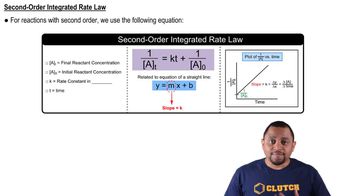Here are the essential concepts you must grasp in order to answer the question correctly.
Second-Order Reactions
A second-order reaction is one where the rate of reaction is proportional to the square of the concentration of one reactant or to the product of the concentrations of two reactants. For the decomposition of acetaldehyde, the rate law can be expressed as rate = k[CH3CHO]^2, where k is the rate constant. Understanding this concept is crucial for analyzing how changes in concentration affect the reaction rate and for calculating the rate constant from pressure data.
Recommended video:
Pressure and Concentration Relationship
In gas-phase reactions, the total pressure of a mixture can be related to the concentrations of the gases involved through the ideal gas law (PV=nRT). For the decomposition of acetaldehyde, as it breaks down into methane and carbon monoxide, the change in total pressure reflects the change in the number of moles of gas. This relationship allows for the conversion of pressure data into concentration values, which is essential for determining the rate constant.
Recommended video:
Units of Rate Constants
Rate constants have different units depending on the order of the reaction. For a second-order reaction, the rate constant k is expressed in units of M⁻¹ s⁻¹, where M is molarity. However, in the context of gas-phase reactions, pressure can be used instead of concentration, leading to units of atm⁻¹ s⁻¹. Understanding how to convert between these units is necessary for accurately reporting the rate constant in the required format.
Recommended video:




